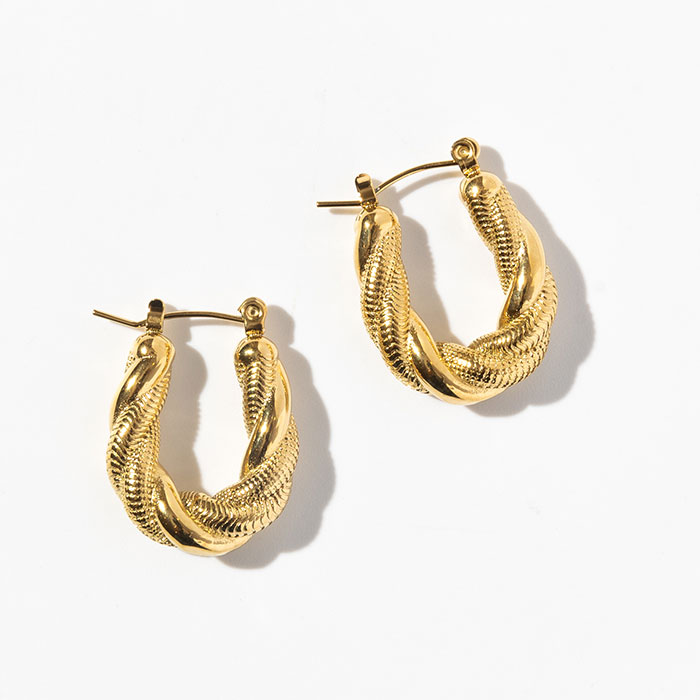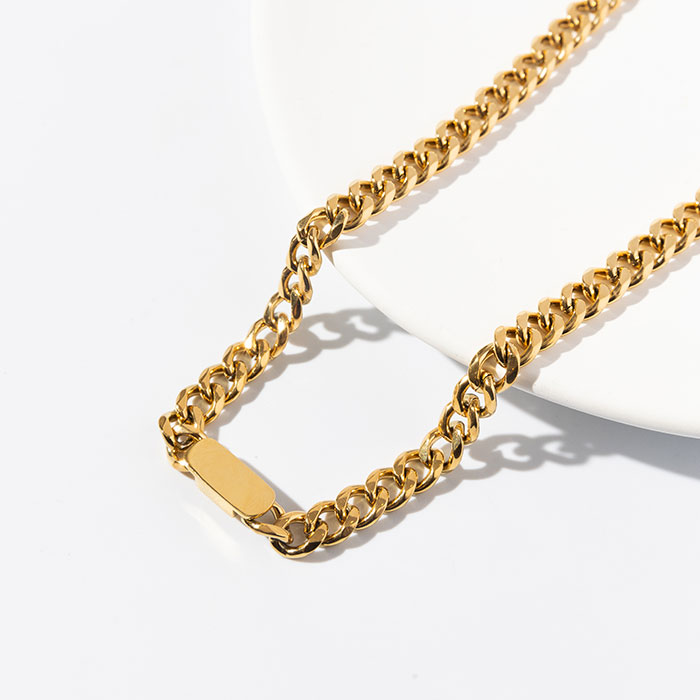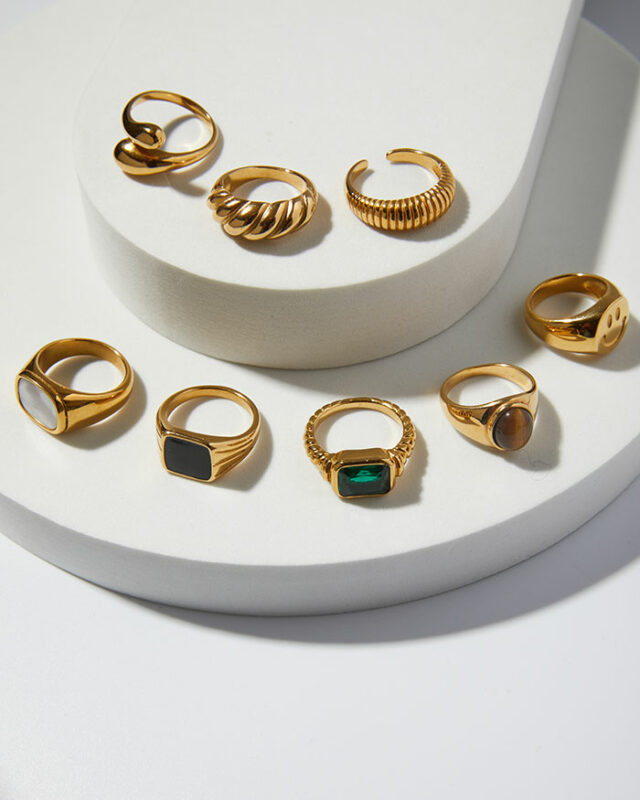Uncategorized
The Magic of Gold-Plated Jewelry: How Does It Stay Tarnish-Free?
Gold-plated jewelry has held a special place in the hearts of many fashion and jewelry lovers, especially those who want the luxurious look of solid gold affordably. Unfortunately, many of these people purchase some of these gold jewelry pieces and then discover that they have begun to discolor, wear, and tarnish shortly after.
Hence the question- can gold plated jewelry really not tarnish? And if yes, how can it remain tarnish-free?
It is essential to establish that not all gold-plated jewelry can be tarnish-free! Jewelry made from metals such as copper, brass, bronze, and alloys can tarnish even when coated with pure gold because of the components of these metals. But those made from metals like titanium, platinum, stainless steel and coated with PVD won’t tarnish.
The magic of gold-coated jewelry lies in its ability to stay tarnish-free and last for years without defying the relentless march of time and maintaining its gleam when other metals succumb to the dulling effect of age and wear.
If you have gold-plated jewelry or are planning to get one, this blog will help you discover the science behind tarnish-free gold-plated jewelry.
The Emergence of Tarnish-free Gold-Plated Jewelry
As the name implies, gold-plated jewelry is rings, necklaces, earrings, or other accessories made with a metal coated by a thin sheet of pure gold. This process has been around since the 19th century when an Italian chemist, Luigi Brugnatelli, developed the process by bonding a thin coating of gold onto a piece of silver.
Since then, it has developed and gained much patronage because of its close resemblance with solid gold. But as time went by, the downsides of this process began to reveal- gold plating becomes dull or discolored over time when it reacts with moisture and air, leading it to oxidize and tarnish.
These downsides, however, led to further development that birthed the creation of gold-plated jewelry that does not tarnish through the use of non-tarnish metals that are Physical vapor deposition (PVD) coated.

The Secret Of Tarnish-Free Gold-plated Jewelry
Why will gold-plated jewelry not tarnish? The secret lies in the process- The composition and techniques of tarnish-free gold-plated jewelry are meticulous enough to ensure the jewelry stays without impairment. Let’s explore some of these below:
· Physical Vapor Deposition (PVD) Coating
You can think of PVD coating as the premium upgrade to the traditional mode of gold plating. In this process, the jewelry is put in a vacuum where the solid gold is turned into tiny bits and stuck to the stainless steel base metal. This makes the jewelry look better and last longer.
This technique is ten times thicker than regular gold plating, making it less susceptible to corrosion, tarnishing, or fading. With a piece of gold plated jewelry that is PVD coated, you don’t have to worry about tarnishing when you sweat, spray perfume on, or wear your jewelry to the pool.
· The Base Metal
Traditionally, the base metals used for gold-plated jewelry are copper, brass, bronze, and alloys. These metals do not promise tarnish-free jewelry because they contain components that make them oxidize and corrode when exposed to moisture and air.
So, which base metals are tarnish-free? Titanium, platinum, stainless steel, and sterling silver are some of the metals that do not tarnish; however, stainless steel remains best for gold plating jewelry. Its nickel, iron, and chromium composition makes it a sustainable medical-grade steel that is corrosion-resistant, color-fading resilient, and tarnish-free.
· Protective Layer
The third secret of tarnish-free gold-plated jewelry is the protective layers that are applied to the base metal before coating. These layers serve as barriers between the metal and the environment or other substances that may destroy the jewelry through direct contact.
· Transparent Sealants
You will be correct to say that gold-plated jewelry has a dual protection layer because after the gold coating has been done, a transparent sealant will be applied to protect the jewelry from external elements that can cause it to tarnish.

Ways to Keep Your Gold-Plated Jewelry Tarnish-free
Regardless of an item’s quality, it will require proper maintenance for longevity, which also applies to gold-plated jewelry. Below are ways you can keep your pieces of gold-plated jewelry from tarnishing.
· Store Properly
When you aren’t wearing your gold-plated jewelry, put it in a plastic bag, then remove the excess air and seal it. The absence of oxygen in the bag will keep the jewelry bright and shiny. Also, put only one piece of jewelry per plastic to avoid scratching. Overall, keep them in a cool and dry place, away from humidity.
· Polish With A Soft Cloth
Soft polishing can drastically extend the lifespan of your gold-plated jewelry. To do this, use chamois or any other non-abrasive, lint-free cloth and polish your jewelry at least once every six months or every three months for those you wear frequently. Be careful not to put a lot of grease when polishing so they don’t rub off the plating.
· Deep Clean Your Gold-Plated Jewelry
If your jewelry needs a deep clean, mix dishwashing liquid with warm water and soak your pieces for just a few minutes before gently wiping them dry. Avoid antibacterial soaps because their formulations can cause gold plating to degrade.
These maintenance practices will ensure your jewelry stays in good shape and tarnish-free.
Tips To Be Sure It Is a Tarnish-Free Jewelry Before You Purchase
Differentiating a piece of tarnish-free gold-plated jewelry from the traditional ones that tarnish can be quite challenging by physical observation for those who are new to it; however, there are things to look out for
· Look out for marks like “PVD,” “GP,” or “IP” that indicate the jewelry is PVD-coated.
· PVS-coated jewelry often has brighter and more consistent gold than the traditional one, so inspecting the color can help you know a tarnish-free one.
· Ask for a jewelry certificate that shows details of the materials and coating used.
· Purchase your gold-plated jewelry from trusted jewelers and retailers that are transparent and known to deal in quality products.
With these tips, you can be sure to go home with a piece of gold-plated jewelry that will last for years.
Final Words on Gold-Plated Jewelry
Gold-plated jewelry offers durability and affordability, and the secret to this durability and tarnish-free nature lies in the protective measures put in place to make them.
However, you must note that while you can get high-quality jewelry from trusted sources like, Pearlory, it is essential for you to take the necessary steps to keep your jewelry from spoiling by careful maintenance.

